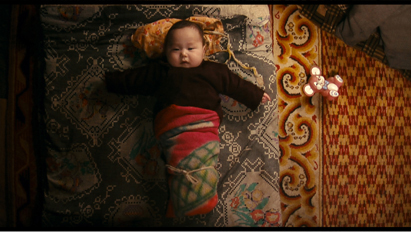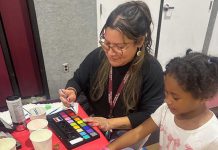
‘Babies’ bring a universal experience to the screen
When filmmakers Thomas Balm
ès and Alain Chabat set out to make their documentary on four
families from different cultures, they broke a few filmmaking
rules. There is no narrator to explain to viewers what is going on.
There are no talking-head experts offering insight. In fact, there
is very little dialogue at all, and the
minimal dialogue that is in the movie is mostly in languages
other than English, with no subtitles to translate it.
‘Babies’ bring a universal experience to the screen
When filmmakers Thomas Balmès and Alain Chabat set out to make their documentary on four families from different cultures, they broke a few filmmaking rules. There is no narrator to explain to viewers what is going on. There are no talking-head experts offering insight. In fact, there is very little dialogue at all, and the minimal dialogue that is in the movie is mostly in languages other than English, with no subtitles to translate it.
It might sound like a strange concept, but given the topic of their documentary it begins to make sense. Chabat came up with the idea of following four babies from birth to their first steps around age one from four different backgrounds. The filmmakers did their best to film the movies in a way that allows the viewers to see the world the way a baby might see it. The film is shot at the level of the babies, from their point of view, and we are left to decipher what their parents mean based on tone, facial expressions and all the nonverbal cues babies use before their spoken language skills develop. In fact, the movie reminded me a bit of a “Peanuts” cartoon, in that the parents were mostly out of the frame and speaking in incomprehensible languages.
“I had this idea 11 to 12 years ago, about watching on a big screen babies growing – without any commentary, but with music,” said Chabat, in a press release. “I felt it could be an emotional experience.”
The filmmakers follow Ponijao, who lives with her family near Opuwo, Namibia; Bayarjargal, who lives with his family near Bayanchandmani, Mongolia; Mari, who lives with her family in Tokyo, Japan; and Hattie, who lives in San Francisco with hers.
“We went with people who were happy and positive about the arrival of a child, which sounds easy, but isn’t,” Balmès said, in a press release. “Alain was saying all the time that we needed to have joy around, and from ourselves too.”
Balmès did the majority of the cinematography for the movie, shooting for 400 days over two years, though some days only a couple hours of filming was done. All that footage was parsed down into a 79-minute documentary that serves to stress the differences in the children’s first year as well as the many similarities.
“I dreamt of a movie theater audience that would applaud because a baby would stand on their own two feet,” Chabat said. “These tiny things are huge adventures for them – and we’ve all been through that, though of course most of us can’t remember. I felt we could show the commonalities as well as the differences among these babies.”
The main thing that connects the babies is that despite differences in their upbringings and their parent’s styles of interaction, they all seem to be very happy babies, at least based on the footage that is edited together. There are plenty of scenes of the babies laughing and exploring their worlds as they learn about everything from getting along with animals in their homes to the right way to eat a banana.
And despite the cultural differences, there are some similar moments that were captured with each family, such as the mothers holding the babies closely and singing a lullaby, or a family pet curiously exploring the new member of the household.
Mari, from Tokyo, and Hattie, from San Francisco, had the most similar interactions with their families. The parents of both babies took them to playgroups with other babies, filled their rooms with toys and books and exposed them to many different places, such as the zoo, the park and the beach. Bayar, from Mongolia, and Ponijao, from Namibia, spent just as much time exploring their surroundings, but seemed limited to a smaller geographical area.
The movie juxtaposes scenes from each of the babies to emphasis the differences and the similarities even more. For instance, as Bayar is left bundled up on a bed in the round house his family lives in on the plains of Mongolia while his parents are off doing the hard work that is required of nomads, Hattie is almost always in the arms of one parent or the other. Ponijao is surrounded by a close-knit family, including her mother, other siblings and tribe members, while the other three babies seem to see grandparents and other family members only on special occasions.
Of course, as with any documentary or reality-based film or TV show, the filmmakers have a lot of control over what is seen. But each of the families had a chance to view the movies, including the babies themselves, in the fall 2009. After watching the movie, the families sat down for a short interview and talked about their thoughts on the movie as well as their reasons for participating.
“We welcomed these [film] people to be in our home; they were helping the whole family, not only Ponijao,” said Ponjijao’s mother, Tarererua.
Like many of the other families, Tarererua said she is glad that Ponijao will have a chance to watch the film when she is older and see how much her family loved and interacted with her.
Mandakh, Bayar’s mother, appreciated the scene of her singing to her baby and touching his cheek. And his father said he liked the scene at the end when Bayar is standing up against the wind outside his home.
“In some part[s], they are all very similar,” said Seiko, Mari’s mother. “In some parts, they’re all so different, in the culture. But they do the same thing[s] and take the same step[s] growing up.”
Hattie’s parents, too, were pleased with the outcome of the movie.
“I loved seeing the footage of her talking; she seems so young and so old at the same time,” said Susie, her mother.
Given the families positive reaction, it seems that the filmmakers did a good job of capturing that first year of life. It is fitting that the last scenes with the babies is them learning to stand and taking their first step. And as each baby does it, there is a sense of pride on their faces, and independence.









